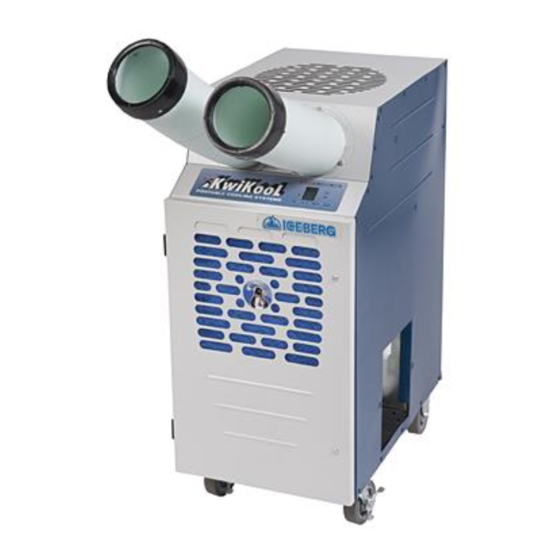
Summarization of Contents
SECTION I UNIT COMPONENTS
KPAC-II Portable Air Conditioner Models and Function
Details the KwiKool KPAC-II portable air conditioners, their purpose, and available models.
SECTION II INSTALLATION AND ASSEMBLY
Air Chutes Standard Equipment Installation
Instructions for installing air supply flanges and attaching air chutes to the unit.
Condensate Tank Operation and Emptying
Details the condensate tank, its float switch, and procedures for emptying.
Ceiling Kit Single Duct Installation
Explains the use of ceiling kits for specific conditioning applications.
Power Connection and Electrical Requirements
Advises on verifying power compatibility and proper use of extension cords.
SECTION III OPERATIONAL SAFEGUARDS
General Operational Safety Warnings
Critical warnings about operation, fire hazards, electrical shock, and moving the unit.
Unit Placement and Handling Cautions
Cautions regarding unit stability, tilt, objects on top, and service doors.
Emergency Contact for Unit Issues
Provides a phone number for assistance with abnormal noises or vibrations.
SECTION IV UNIT OPERATION
Applying Electrical Power to the Unit
Describes the unit's behavior and display upon initial power connection.
Control Panel Overview and Button Functions
Explains the purpose and operation of each button on the control panel.
System Operation Modes and Settings
Details turning the unit on, setting temperature, and using COOL/FAN modes.
SECTION V BUILT IN SAFEGUARDS
Compressor Time Delay Safeguard
Explains the mechanism protecting the compressor from short cycling.
High Pressure Switch and Alarm Protection
Describes the high-pressure switch, its protective function, and manual reset.
Automatic Restart After Power Loss
Details how the unit resumes operation after a power interruption.
Condensate Tank High Level Alarm
Explains the condensate tank's overflow safety cut-off and alarm.
Service Port Identification
Identifies the location of service ports for system pressure monitoring.
SECTION VI APPLICATION REQUIREMENTS
Unit Air Temperature Requirements
Specifies the required ambient air temperatures for optimal unit operation.
Unit Capacity and Temperature Settings
Discusses unit sizing and recommended temperature settings for efficiency.
Optimal Unit Positioning Guidelines
Provides advice on placing the unit for correct airflow and performance.
SECTION VII MAINTENANCE
Air Filter Maintenance and Replacement
Explains the purpose, type, and periodic maintenance of air filters.
SECTION VIII FAULT CODES
KPAC-II Fault Code Summary
Lists common fault codes displayed by the system and their general meaning.
SECTION IX KPAC TROUBLESHOOTING GUIDE
Troubleshooting CF Fault: Condensate Tank
Addresses issues when the unit displays CF and the alarm won't clear.
Troubleshooting AL Fault: High Pressure
Details solutions for the AL fault indicating high pressure or tripped switch.
Troubleshooting FP Fault: Evaporator Freezing
Provides troubleshooting steps for the FP fault related to evaporator coil freezing.
Troubleshooting Time Out and No Cooling
Addresses issues when the system is in time out or not supplying conditioned air.
Troubleshooting Power Issues and Blank Display
Covers troubleshooting for voltage drops, power problems, and blank control displays.
Troubleshooting Tripped Breaker and Power
Troubleshoots system tripping breakers and incorrect incoming power.
Troubleshooting Cooling and Airflow Problems
Addresses units not cooling, limited airflow, and dripping water.
Troubleshooting Evaporator Coil Freezing
Lists causes and solutions for evaporator coil freezing.
Troubleshooting Chatter, Hum, and Ambient Temp
Covers troubleshooting chatter/hum, and 99/59 flashes for ambient temperature.











Need help?
Do you have a question about the KPAC 1411-2 and is the answer not in the manual?
Questions and answers